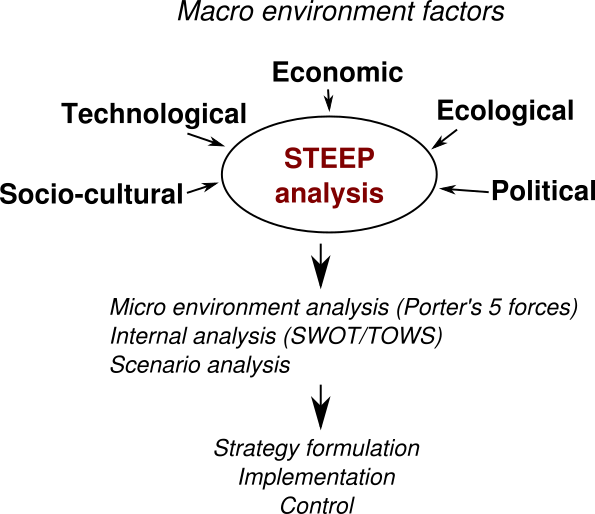STEEP analysis
STEEP analysis is one variant of the very popular and simple strategic management method for analysis of external environment of the organization. It is based on PEST analysis method, with addition of additional Environmental factor. External environment has a significant effect on business activities but these forces are independent from management decisions and actions.
Contents
- 1 Main factors of STEEP analysis
- 2 Example of STEEP analysis
- 3 Steps of STEEP analysis
- 4 Advantages of STEEP analysis
- 5 Limitations of STEEP analysis
- 6 Other similar strategic management methods
- 7 References
Main factors of STEEP analysis
Five external factors influencing organization is considered:
- S ocio-cultural - social forces influence our attitudes, interests, opinions, moreover create our behavior and ultimately what we purchase. Trends’ changes have correspondingly direct impact on enterprises. These factors contain: structure of population, falling rates, competition, increase of global population, traditions, level of education, cultural diversity and standards,
See more examples of Social and cultural factors affecting business
- Techonological - technological advances have greatly changed the manner in which businesses operate. Nowadays technological progress created a society which expects instant results. Here we can mention: new technologies, absorptive capacity for innovation, globalization. New technologies shorten Product life cycle and increase demand for new products. This revolution has increased the rate at which information is exchanged between stakeholders. A faster exchange of information can benefit companies as they are able to react quickly to changes.
See more examples of Technological factors affecting business

Fig. 1. Place of STEEP analysis within strategic management process
- Economic - national interest rates and fiscal policy is set around economic conditions, besides has influence on purchasing power of consumers and structure of their expenditure. These factors include: gross domestic product (GDP) creating by demand, stock quote, currency rate fluctuations, rate of inflations, market substitutive and complementary, tax policy, price changes, revenues, savings and level of unemployment, and also business ethics.
See more examples of Economic factors affecting business
- Environmental - environmental protection legislation, pollution, waste management and disposal, clean air and water, energy saving technologies, attitudes towards ecology in society,
- P olitical - factors could create plenty of advantages and opportunities for organizations. These factors include: political situation, political stability, state legislation, state interference, market regulations, trade agreements, tariffs or restrictions, taxes, lobbying and clarity of law.
See more examples of Political factors affecting business
Above mentioned external environment factors, can have both positive influence (then they are called opportunities) or negative influence (and then they are called threats).
Example of STEEP analysis
A company that produces and sells electric cars wants to expand its market share. It conducts a STEEP analysis and finds the following:
- Social: There is an increasing trend towards environmental consciousness and sustainable living.
- Technological: Advancements in battery technology have made electric cars more efficient and affordable.
- Economic: Government incentives for electric car ownership and declining costs of production have made it more profitable to produce and sell electric cars.
- Environmental: Stringent emissions regulations and increasing concerns about air pollution are driving the demand for electric cars.
- Political: Government support for electric cars through subsidies and tax credits and a focus on reducing dependence on fossil fuels.
Based on this analysis, the company can conclude that there is a favorable market for electric cars, and should consider expanding its production and sales.
Steps of STEEP analysis
The steps of a STEEP analysis typically include the following:
- Social: Analyze demographic trends, consumer attitudes, and lifestyle changes that may impact the organization.
- Technological: Assess advances in technology that may affect the organization's operations, products, or services.
- Economic: Analyze economic conditions that may impact the organization's financial performance, such as interest rates, inflation, and unemployment.
- Environmental: Evaluate the impact of environmental issues such as climate change, natural disasters, and regulations on the organization.
- Political: Analyze the impact of government policies, regulations, and political stability on the organization.
- Identify opportunities and threats: Using the information gathered from the above steps, identify opportunities and threats that may impact the organization.
- Develop strategies: Use the information from the STEEP analysis to develop strategies that address the opportunities and threats identified.
- Implementation: Implement the strategies developed in step 7 and monitor their effectiveness in addressing the opportunities and threats identified in the STEEP analysis.
- Review and update: Regularly review and update the STEEP analysis to reflect changes in the external environment and adapt the strategies accordingly.
Advantages of STEEP analysis
There are several advantages to using a STEEP analysis in strategic planning:
- Comprehensive view: STEEP analysis takes into account a wide range of external factors that can impact an organization, providing a more complete picture of the environment in which the organization operates.
- Identifying opportunities: By analyzing social, technological, economic, environmental, and political factors, organizations can identify potential new opportunities for growth and expansion.
- Identifying threats: STEEP analysis can also help organizations identify potential threats to their operations and take steps to mitigate them.
- Flexibility: The STEEP analysis can be applied to any organization, regardless of its size, industry, or location.
- Improved decision making: A STEEP analysis can provide valuable insights and information that can inform strategic decision making and help organizations make better decisions.
- Proactive approach: By performing a STEEP analysis, organizations can take a proactive approach to managing their external environment, rather than simply reacting to changes as they occur.
Limitations of STEEP analysis
There are several limitations to using a STEEP analysis in strategic planning:
- Time-consuming: Conducting a comprehensive STEEP analysis can be time-consuming and may require significant resources.
- Lack of precision: The external factors considered in a STEEP analysis are often difficult to quantify, which can make it difficult to accurately assess the potential impact of these factors on an organization.
- Limited focus on internal factors: While a STEEP analysis takes into account external factors, it does not focus on internal factors such as organizational structure, culture, or capabilities.
- Dependence on secondary data: A STEEP analysis typically relies on secondary data sources, which can be limited in scope and accuracy, and may not reflect the specific conditions of a particular organization.
- Assumptions: The analysis is based on assumptions and predictions about the future, which may not always be accurate.
- Limited flexibility: Some organizations may find that the framework of the STEEP analysis does not align with their specific needs or goals.
- Short-term focus: A STEEP analysis generally focuses on short-term trends and events, it may not be effective in identifying long-term changes that could have a major impact on an organization.
Other similar strategic management methods
There are several other strategic management methods that are similar to the STEEP analysis and can be used to evaluate the external factors that can affect a company or organization. Some of these include:
- PESTLE analysis: This method is similar to the STEEP analysis, but it includes additional factors, such as Legal and Ethical considerations.
- SWOT analysis: This method is used to evaluate a company's internal strengths and weaknesses, as well as external opportunities and threats. It can be used in conjunction with a STEEP or PESTLE analysis to provide a more comprehensive view of a company's strategic position.
- Five Forces Analysis: Developed by Michael Porter, this method analyzes the competitive forces in an industry, including the threat of new entrants, the bargaining power of suppliers and buyers, the threat of substitute products or services, and the intensity of competitive rivalry.
- Scenario planning: This method involves creating several plausible scenarios for the future and developing strategies to respond to each of them.
- BCG matrix: This method is used to evaluate a company's portfolio of products or business units, by plotting them on a matrix based on their relative market share and growth rate.
Each of these methods has its own strengths and weaknesses, and the choice of which method to use will depend on the specific situation and the information available.
| STEEP analysis — recommended articles |
| STEEPLE analysis — Macro environment analysis — PEST analysis — External analysis — Opportunities and threats — Environmental factors affecting business — Factors affecting business — Company situation analysis — ASTRA analysis |
References
- Bowman, C. (1998). Strategy in practice (p. 201). Prentice Hall Europe.
- Pearce, J. A., Robinson, R. B., & Subramanian, R. (2000). Strategic management: Formulation, implementation, and control. Columbus, OH: Irwin/McGraw-Hill.

